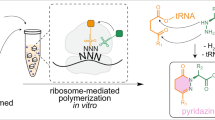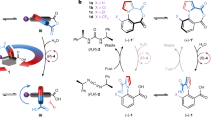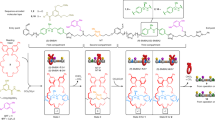Abstract
Biomolecular machines perform types of complex molecular-level tasks that artificial molecular machines can aspire to. The ribosome, for example, translates information from the polymer track it traverses (messenger RNA) to the new polymer it constructs (a polypeptide)1. The sequence and number of codons read determines the sequence and number of building blocks incorporated into the biomachine-synthesized polymer. However, neither control of sequence2,3 nor the transfer of length information from one polymer to another (which to date has only been accomplished in man-made systems through template synthesis)4 is easily achieved in the synthesis of artificial macromolecules. Rotaxane-based molecular machines5,6,7 have been developed that successively add amino acids8,9,10 (including β-amino acids10) to a growing peptide chain by the action of a macrocycle moving along a mono-dispersed oligomeric track derivatized with amino-acid phenol esters. The threaded macrocycle picks up groups that block its path and links them through successive native chemical ligation reactions11 to form a peptide sequence corresponding to the order of the building blocks on the track. Here, we show that as an alternative to translating sequence information, a rotaxane molecular machine can transfer the narrow polydispersity of a leucine-ester-derivatized polystyrene chain synthesized by atom transfer radical polymerization12 to a molecular-machine-made homo-leucine oligomer. The resulting narrow-molecular-weight oligomer folds to an α-helical secondary structure13 that acts as an asymmetric catalyst for the Juliá–Colonna epoxidation14,15 of chalcones.
This is a preview of subscription content, access via your institution
Access options
Access Nature and 54 other Nature Portfolio journals
Get Nature+, our best-value online-access subscription
$29.99 / 30 days
cancel any time
Subscribe to this journal
Receive 12 print issues and online access
$259.00 per year
only $21.58 per issue
Buy this article
- Purchase on Springer Link
- Instant access to full article PDF
Prices may be subject to local taxes which are calculated during checkout




Similar content being viewed by others
References
Yonath, A. Hibernating bears, antibiotics, and the evolving ribosome (Nobel Lecture). Angew. Chem. Int. Ed. 49, 4340–4354 (2010).
Lutz, J.-F., Ouchi, M., Liu, D. R. & Sawamoto, M. Sequence-controlled polymers. Science 341, 1238149 (2013).
ten Brummelhuis, N. Controlling monomer-sequence using supramolecular templates. Polym. Chem. 6, 654–667 (2015).
Polowinski, S. Template polymerisation and co-polymerisation. Prog. Polym. Sci. 27, 537–577 (2002).
Erbas-Cakmak, S., Leigh, D. A., McTernan, C. T. & Nussbaumer, A. L. Artificial molecular machines. Chem. Rev. 115, 10081–10206 (2015).
Sauvage, J.-P. From chemical topology to molecular machines (Nobel Lecture). Angew. Chem. Int. Ed. 56, 11080–11093 (2017).
Stoddart, J. F. Mechanically interlocked molecules (MIMs)—molecular shuttles, switches, and machines (Nobel Lecture). Angew. Chem. Int. Ed. 56, 11094–11125 (2017).
Lewandowski, B. et al. Sequence-specific peptide synthesis by an artificial small-molecule machine. Science 339, 189–193 (2013).
De Bo, G. et al. Efficient assembly of threaded molecular machines for sequence-specific synthesis. J. Am. Chem. Soc. 136, 5811–5814 (2014).
De Bo, G. et al. Sequence-specific β-peptide synthesis by a rotaxane-based molecular machine. J. Am. Chem. Soc. 139, 10875–10879 (2017).
Dawson, P. E., Muir, T. W., Clark-Lewis, I. & Kent, S. B. Synthesis of proteins by native chemical ligation. Science 266, 776–779 (1994).
Matyjaszewski, K. & Tsarevsky, N. V. Macromolecular engineering by atom transfer radical polymerization. J. Am. Chem. Soc. 136, 6513–6533 (2014).
Andrews, M. J. I. & Tabor, A. B. Forming stable helical peptides using natural and artificial amino acids. Tetrahedron 55, 11711–11743 (1999).
Juliá, S., Masana, J. & Vega, J. C. ‘Synthetic enzymes’. Highly stereoselective epoxidation of chalcone in a triphasic toluene-water-poly[(S)-alanine] system. Angew. Chem. Int. Ed. 19, 929–931 (1980).
Juliá, S. et al. Synthetic enzymes. Part 2. Catalytic asymmetric epoxidation by means of polyamino-acids in a triphase system. J. Chem. Soc., Perkin Trans. 1, 1317–1324 (1982).
Thordarson, P., Bijsterveld, E. J. A., Rowan, A. E. & Nolte, R. J. M. Epoxidation of polybutadiene by a topologically linked catalyst. Nature 424, 915–918 (2003).
van Dongen, S. F. M. et al. A clamp-like biohybrid catalyst for DNA oxidation. Nat. Chem. 5, 945–951 (2013).
Lewandowski, B. & Wennemers, H. Asymmetric catalysis with short-chain peptides. Curr. Opin. Chem. Biol. 22, 40–46 (2014).
Braun, D. et al. Analysis of the linear methods for determining copolymerization reactivity ratios, VII. A critical reexamination of radical copolymerizations of styrene. Angew. Makromol. Chem. 125, 161–205 (1984).
Young, R. J. & Lovell, P. A. Introduction to Polymers 3rd edn (CRC Press, Boca Raton, 2011).
Coessens, V. & Matyjaszewski, K. Dehalogenation of polymers prepared by atom transfer radical polymerization. Macromol. Rapid Comm. 20, 66–70 (1999).
Beychok, S. Circular dichroism of biological macromolecules. Science 154, 1288–1299 (1966).
Flood, R. W. et al. Efficient asymmetric epoxidation of α,β-unsaturated ketones using a soluble triblock polyethylene glycol−polyamino acid catalyst. Org. Lett. 3, 683–686 (2001).
Wan, Q. & Danishefsky, S. J. Free‐radical‐based, specific desulfurization of cysteine: a powerful advance in the synthesis of polypeptides and glycopolypeptides. Angew. Chem. Int. Ed. 46, 9248–9252 (2007).
Hernández, J. V., Kay, E. R. & Leigh, D. A. A reversible synthetic rotary molecular motor. Science 306, 1532–1537 (2004).
Chatterjee, M. N., Kay, E. R. & Leigh, D. A. Beyond switches: ratcheting a particle energetically uphill with a compartmentalized molecular machine. J. Am. Chem. Soc. 128, 4058–4073 (2006).
Serreli, V., Lee, C.-F., Kay, E. R. & Leigh, D. A. A molecular information ratchet. Nature 445, 523–527 (2007).
Wilson, M. R. et al. An autonomous chemically fuelled small-molecule motor. Nature 534, 235–240 (2016).
von Delius, M., Geertsema, E. M. & Leigh, D. A. A synthetic small molecule that can walk down a track. Nat. Chem. 2, 96–101 (2010).
Kassem, S., Lee, A. T. L., Leigh, D. A., Markevicius, A. & Solà, J. Pick-up, transport and release of a molecular cargo using a small-molecule robotic arm. Nat. Chem. 8, 138–143 (2015).
Kassem, S. et al. Stereodivergent synthesis with a programmable molecular machine. Nature 549, 374–378 (2017).
Acknowledgements
The authors thank M. Turner and J. Behrendt for assistance with the SEC instrumentation, J. Clayden and M. De Poli for assistance with CD measurements and G. Smith for MALDI analysis of earlier related systems. The UMONS MS laboratory acknowledges the Fonds National de la Recherche Scientifique (FRS-FNRS) for its contribution to acquisition of the Waters QToF Premier and Synapt G2-Si mass spectrometers and for continuing support. This research was funded by the Engineering and Physical Sciences Research Council (EP/P027067/1). The authors thank the Royal Society for a University Research Fellowship (to G.D.B.) and a Research Professorship (to D.A.L.).
Author information
Authors and Affiliations
Contributions
G.D.B., M.A.Y.G. and S.K. planned and carried out the experimental work. J.D.W. and P.G. performed the MS analysis of polymers 1 and 3. D.A.L. directed the research. All authors contributed to the analysis of the results and the writing of the manuscript.
Corresponding author
Ethics declarations
Competing interests
The authors declare no competing interests.
Additional information
Publisher’s note: Springer Nature remains neutral with regard to jurisdictional claims in published maps and institutional affiliations.
Supplementary information
Supplementary Information
Supplementary Information
Rights and permissions
About this article
Cite this article
De Bo, G., Gall, M.A.Y., Kuschel, S. et al. An artificial molecular machine that builds an asymmetric catalyst. Nature Nanotech 13, 381–385 (2018). https://doi.org/10.1038/s41565-018-0105-3
Received:
Accepted:
Published:
Issue Date:
DOI: https://doi.org/10.1038/s41565-018-0105-3
This article is cited by
-
Force-controlled release of small molecules with a rotaxane actuator
Nature (2024)
-
Ratcheting synthesis
Nature Reviews Chemistry (2023)
-
A tape-reading molecular ratchet
Nature (2022)
-
Controlling catalyst activity, chemoselectivity and stereoselectivity with the mechanical bond
Nature Reviews Chemistry (2022)
-
Towards artificial molecular factories from framework-embedded molecular machines
Nature Reviews Chemistry (2020)



